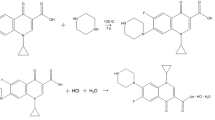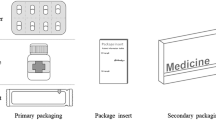Abstract
Manufacturing organizations are under continuous pressure to implement sustainability in their activities. There is a need to identify the environmental hotspots in the manufacturing processes of the products. In this research life cycle assessment technique has been used to achieve the objective of identifying the maximum impact-generating processes in the production of a pharmaceutical product named ‘Paracetamol tablet.’ The study identifies the environmental impacts of the paracetamol tablet manufacturing in the endpoint and midpoint impact categories. Three main environmental hotspot processes are identified during this study. The midpoint assessment results show that the ‘blister packing’ is the top environmental hotspot owing to the consumption of resources of the packaging material. ‘Blister packing’ has a significant contribution to the seven impact categories. Blister packaging has more than 70% environmental impact in freshwater eutrophication and human toxicity categories. The packaging for the tablet mainly consists of the PVC and aluminum blister, which cause a lot of environmental impact during their production. The ‘Blister packing’ process is followed by the ‘sieving process,’ which has more than 80% contribution in land use and metal depletion impact category. To reduce the impacts arising during the ‘sieving’ process will require improvements in the electricity mix, such as increasing the renewable component in the mix. The third hotspot process is ‘steam production,’ which shows its presence in almost all the categories varying from 8% to 50%. More efficient ways of steam production like solar-based steam generation will make steam production more environmentally viable. The robustness of the results has been verified using the sensitivity analysis. Possible solutions to reduce the environmental impacts of the hotspot processes have been provided.
Graphic abstract







Similar content being viewed by others
References
Alsaffar AJ, Raoufi K, Kim K-Y, Okudan Kremer GE, Haapala KR (2016) Simultaneous consideration of unit manufacturing processes and supply chain activities for reduction of product environmental and social impacts. J Manuf Sci Eng 138(10):101009. https://doi.org/10.1115/1.4034481
Belboom S, Renzoni R, Verjans B, Léonard A, Germain A (2011) A life cycle assessment of injectable drug primary packaging: comparing the traditional process in glass vials with the closed vial technology (polymer vials). Int J Life Cycle Assess 16(2):159–167. https://doi.org/10.1007/s11367-011-0248-z
Bhakar V, Agur A, Digalwar AK, Sangwan KS (2015) Life cycle assessment of CRT, LCD and LED monitors. Proc CIRP 29:432–437
Bilcare Research (2018) Blister packaging solutions. https://betterblisters.com/blister-packaging-solutions/
Carole WA, Slater CS, Savelski MJ, Moroz T, Furiato A, Lynch K (2008) Use of life cycle assessment in evaluating solvent recovery alternatives in pharmaceutical manufacture. 8th International conference on ecobalance. Tokyo, Japan
Cespi D, Beach ES, Swarr TE, Passarini F, Vassura I, Dunn PJ, Anastas PT (2015) Life cycle inventory improvement in the pharmaceutical sector: assessment of the sustainability combining PMI and LCA tools. Green Chem 17(6):3390–3400. https://doi.org/10.1039/C5GC00424A
Chang YJ, Schau EM, Finkbeiner M (2012) Application of life cycle sustainability assessment to the bamboo and aluminum bicycles in surveying social risks of developing countries. 2nd World sustainability forum, web conference, pp 1-30
Chittoor R, Ray S, Aulakh PS, Sarkar MB (2008) Strategic responses to institutional changes: ‘Indigenous growth’ model of the Indian pharmaceutical industry. J Int Manag 14(3):252–269. https://doi.org/10.1016/j.intman.2008.05.001
de Boer IJM (2003) Environmental impact assessment of conventional and organic milk production. Livest Prod Sci 80(1–2):69–77. https://doi.org/10.1016/S0301-6226(02)00322-6
De Soete W, Dewulf J, Cappuyns P, Van der Vorst G, Heirman B, Aelterman W, Schoeters K, Van Langenhove H (2013) Exergetic sustainability assessment of batch versus continuous wet granulation based pharmaceutical tablet manufacturing: a cohesive analysis at three different levels. Green Chem 15(11):3039. https://doi.org/10.1039/c3gc41185k
Dhaliwal H, Browne M, Flanagan W, Laurin L, Hamilton M (2014) A life cycle assessment of packaging options for contrast media delivery: comparing polymer bottle versus glass bottle. Int J Life Cycle Assess 19(12):1965–1973. https://doi.org/10.1007/s11367-014-0795-1
Dong YH, Ng ST (2014) Comparing the midpoint and endpoint approaches based on ReCiPe—a study of commercial buildings in Hong Kong. Int J Life Cycle Assess 19(7):1409–1423. https://doi.org/10.1007/s11367-014-0743-0
Emara Y, Siegert M-W, Lehmann A, Finkbeiner M (2018) Life cycle management in the pharmaceutical industry using an applicable and robust LCA-based environmental sustainability assessment approach. In: Benetto E, Gericke K, Guiton M (eds) Designing sustainable technologies, products and policies. Springer, NewYork, pp 79–88. https://doi.org/10.1007/978-3-319-66981-6_9
Emara Y, Lehmann A, Siegert M-W, Finkbeiner M (2019) Modeling pharmaceutical emissions and their toxicity-related effects in life cycle assessment (LCA): a review. Integ Environ Assess Manag 15(1):6–18. https://doi.org/10.1002/ieam.4100
Fuhr (2013) Easy ways to save energy now – take care of those steam traps [PDF file]. Retrieved from https://www.energy.gov/sites/prod/files/2013/11/f4/webinar_steamtrap_2010_0605_0.pdf
GaBi Software (2019) http://www.gabi-software.com/international/software/gabi-software/
Garetti M, Taisch M (2012) Sustainable manufacturing: trends and research challenges. Prod Plan Control 23(2–3):83–104. https://doi.org/10.1080/09537287.2011.591619
Godha A, Jain P (2015) Sustainability reporting trend in indian companies as per GRI framework: a comparative study. South Asian J Bus Manag Cases 4(1):62–73. https://doi.org/10.1177/2277977915574040
Goedkoop M, Heijungs R, Huijbregts M, De Schryver A, Struijs J, Van Zelm R (2009) ReCiPe 2008- A life cycle impact assessment method which comprises harmonised category indicators at the midpoint and the endpoint level, 1, 1–126. https://www.rivm.nl/documenten/a-lcia-method-which-comprises-harmonised-category-indicators-at-midpoint-and-endpoint
González-García S, Castanheira ÉG, Dias AC, Arroja L (2013) Environmental life cycle assessment of a dairy product: the yoghurt. Int J Life Cycle Assess 18(4):796–811. https://doi.org/10.1007/s11367-012-0522-8
Jacquemin L, Pontalier P-Y, Sablayrolles C (2012) Life cycle assessment (LCA) applied to the process industry: a review. Int J Life Cycle Assess 17(8):1028–1041. https://doi.org/10.1007/s11367-012-0432-9
Jain S, Shao G, Brodsky A, Riddick F (2013) A model based continuous improvement methodology for sustainable manufacturing. In: Prabhu V, Taisch M, Kiritsis D (eds) Advances in production management systems sustainable production and service supply chains, vol 414. Springer, Berlin, pp 268–277. https://doi.org/10.1007/978-3-642-41266-0_33
Jiménez-González C, Overcash MR (2014) The evolution of life cycle assessment in pharmaceutical and chemical applications—a perspective. Green Chem 16(7):3392–3400. https://doi.org/10.1039/C4GC00790E
Jiménez-González C, Curzons AD, Constable DJ, Cunningham VL (2004) Cradle-to-gate life cycle inventory and assessment of pharmaceutical compounds. Int J Life Cycle Assess 9(2):114–121
Keystone Folding Box Company (2011) Ecoslide-RX. http://ecoslide-rx.com
Laskar N, Maji SG (2016) Corporate sustainability reporting practices in India: myth or reality? Soc Responsib J 12(4):625–641. https://doi.org/10.1108/SRJ-05-2015-0065
Li X, Jia RY, Hou JJ (2014) LCA of the clean air conditioning system in pharmaceutical industry. Appl Mech Mater 644–650:6343–6346. https://doi.org/10.4028/www.scientific.net/AMM.644-650.6343
Lucato W, Santos J, Pacchini A (2017) Measuring the sustainability of a manufacturing process: a conceptual framework. Sustainability 10(2):81. https://doi.org/10.3390/su10010081
Mata TM, Martins AA, Neto B, Martins ML, Salcedo RLR, Costa CAV (2012) LCA tool for sustainability evaluations in the pharmaceutical industry. Chem Eng Trans 26:261–266
Mazumdar M (2013) An overview of the Indian pharmaceutical sector. In: Mazumdar M (ed) Performance of pharmaceutical companies in India. Physica-Verlag HD, Berlin, pp 17–44. https://doi.org/10.1007/978-3-7908-2876-4_2
Moldavska A, Welo T (2017) The concept of sustainable manufacturing and its definitions: a content-analysis based literature review. J Clean Prod 166:744–755. https://doi.org/10.1016/j.jclepro.2017.08.006
Nayak AK (2010) Comparative in vitro dissolution assessment of some commercially available paracetamol tablets. Int J Pharm Sci Rev Res 2(1):2
Niero M, Pizzol M, Bruun HG, Thomsen M (2014) Comparative life cycle assessment of wastewater treatment in Denmark including sensitivity and uncertainty analysis. J Clean Prod 68:25–35
Nygren J, Riina A (2010) Use of life cycle assessment (LCA) in global companies. Finnish Environment Institute, Helsinki
Ott D, Kralisch D, Denčić I, Hessel V, Laribi Y, Perrichon PD, Berguerand C, Kiwi-Minsker L, Loeb P (2014) Life cycle analysis within pharmaceutical process optimization and intensification: case study of active pharmaceutical ingredient production. Chemsuschem 7(12):3521–3533. https://doi.org/10.1002/cssc.201402313
Paracetamol Market Demands, Competitive Insights And Precise Outlook 2019–2024 (2019). Industry Reports. https://industryreports24.com/89401/paracetamol-market-demands-competitive-insights-and-precise-outlook-2019-2024/
Park C-W, Kwon K-S, Kim W-B, Min B-K, Park S-J, Sung I-H, Yoon YS, Lee K-S, Lee J-H, Seok J (2009) Energy consumption reduction technology in manufacturing—a selective review of policies, standards, and research. Int J Precis Eng Manuf 10(5):151–173. https://doi.org/10.1007/s12541-009-0107-z
Peralta Álvarez ME, Marcos Bárcena M, Aguayo González F (2016) A review of sustainable machining engineering: optimization process through triple bottom line. J Manuf Sci Eng 138(10):100801. https://doi.org/10.1115/1.4034277
Raju G, Sarkar P, Singla E, Singh H, Sharma RK (2016) Comparison of environmental sustainability of pharmaceutical packaging. Perspect Sci 8:683–685. https://doi.org/10.1016/j.pisc.2016.06.058
ReCiPe | PRé Sustainability (2019). https://www.pre-sustainability.com/recipe
Sada GKA, Jaffal HM, Fahad RS, Abdullah WN (2017) Utilization solar energy for steam production. Int J Adv Res Eng Tech 8(5):13–18
Seow Y, Rahimifard S (2011) A framework for modelling energy consumption within manufacturing systems. CIRP J Manuf Sci Technol 4(3):258–264. https://doi.org/10.1016/j.cirpj.2011.03.007
Siegert M-W, Lehmann A, Emara Y, Finkbeiner M (2018) Harmonized rules for future LCAs on pharmaceutical products and processes. Int J Life Cycle Assess. https://doi.org/10.1007/s11367-018-1549-2
Sierra Coating Technologies (2016) Finding a cost-effective poly replacement for packaging. https://www.sierracoating.com/poly-replacement-packaging
Singh K, Sultan I (2017) Framework for sustainability performance assessment for manufacturing processes—a review. IOP Conf Ser Earth Environ Sci 73:012029. https://doi.org/10.1088/1755-1315/73/1/012029
Smith L, Ball P (2012) Steps towards sustainable manufacturing through modelling material, energy and waste flows. Int J Prod Econ 140(1):227–238. https://doi.org/10.1016/j.ijpe.2012.01.036
Tillman A-M, Ekvall T, Baumann H, Rydberg T (1994) Choice of system boundaries in life cycle assessment. J Clean Prod 2(1):21–29. https://doi.org/10.1016/0959-6526(94)90021-3
Veleva V, Hart M, Greiner T, Crumbley C (2003) Indicators for measuring environmental sustainability: a case study of the pharmaceutical industry. Benchmark Int J 10(2):107–119. https://doi.org/10.1108/14635770310469644
Wernet G, Conradt S, Isenring HP, Jiménez-González C, Hungerbühler K (2010) Life cycle assessment of fine chemical production: a case study of pharmaceutical synthesis. Int J Life Cycle Assess 15(3):294–303. https://doi.org/10.1007/s11367-010-0151-z
Zhao GY, Liu ZY, He Y, Cao HJ, Guo YB (2017) Energy consumption in machining: classification, prediction, and reduction strategy. Energy 133:142–157. https://doi.org/10.1016/j.energy.2017.05.110
Author information
Authors and Affiliations
Corresponding author
Additional information
Publisher's Note
Springer Nature remains neutral with regard to jurisdictional claims in published maps and institutional affiliations.
Rights and permissions
About this article
Cite this article
Sharma, R.K., Sarkar, P. & Singh, H. Assessing the sustainability of a manufacturing process using life cycle assessment technique—a case of an Indian pharmaceutical company. Clean Techn Environ Policy 22, 1269–1284 (2020). https://doi.org/10.1007/s10098-020-01865-4
Received:
Accepted:
Published:
Issue Date:
DOI: https://doi.org/10.1007/s10098-020-01865-4




